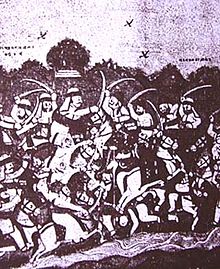| Battle of Bhuchar Mori | |||||||||
|---|---|---|---|---|---|---|---|---|---|
| Part of Akbar's conquest of Gujarat | |||||||||
 Sketch from the Yaduvanshprakash by Mavdanji Ratnu, 1934 | |||||||||
| |||||||||
| Belligerents | |||||||||
|
Junagadh State |
Gujarat Sultanate Nawanagar State Cutch State Muli State | ||||||||
| Commanders and leaders | |||||||||
|
Daulat Khan Ghori |
Muzaffar Shah III Jam Sataji Jam Ajaji † Jasa Vajir † Rao Bharmalji I Sanganji Vadher Vasaji Parmar | ||||||||
| Strength | |||||||||
| |||||||||
| Casualties and losses | |||||||||
| The numbers are derived from agreement of various sources.[1] | |||||||||
Location of battle in Gujarat | |||||||||
The Battle of Bhuchar Mori, also known as Battle of Dhrol, was fought between the army of Kathiawar led by Nawanagar State and the Mughal army at Bhuchar Mori plateau near Dhrol, Saurashtra (now in Jamnagar district, Gujarat, India). It was meant to protect Muzaffar Shah III, the last Sultan of Gujarat Sultanate who had taken asylum under Jam Sataji of Nawanagar after his escape from the Mughal emperor Akbar. It was fought in July 1591 (Vikram Samvat 1648). The Kathiawar army included the armies of Junagadh who betrayed Nawanagar and joined the Mughal army at last. The battle led to a large number of casualties on both sides. The battle resulted in the victory of the Mughal army.[4][2]
It is considered the largest battle in the history of Saurashtra. It is often dubbed as the Panipat of Saurashtra.[2]
- ^ a b c d e f g Cite error: The named reference
PHIwas invoked but never defined (see the help page). - ^ a b c Jadav, Joravarsinh (29 April 2012). "આશરા ધર્મને ઉજાગર કરતી સૌરાષ્ટ્રની સૌથી મોટી ભૂચર મોરીની લડાઇ - લોકજીવનનાં મોતી". Gujarat Samachar (in Gujarati). Archived from the original on 10 May 2016. Retrieved 10 May 2016.
- ^ a b c Cite error: The named reference
TS1882was invoked but never defined (see the help page). - ^ Georg Pfeffer; Deepak Kumar Behera (1997). Contemporary Society: Concept of tribal society. Concept Publishing Company. p. 198. ISBN 978-81-7022-983-4.


